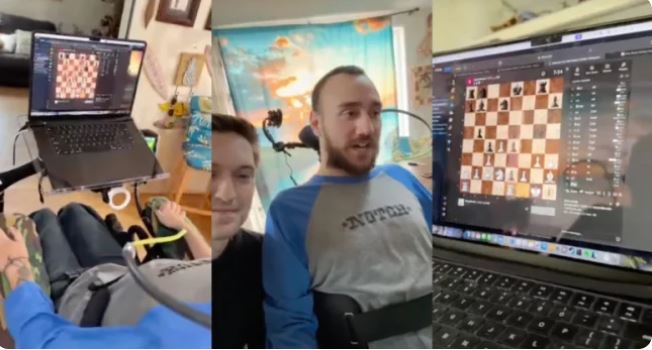
First patient with Neuralink implant in his brain already beats healthy people at computer games
A quadriplegic due to a spinal cord injury who became the first person to have a Neuralink brain implant, now has advanced enough to use his mind to use a computer and even beat healthy people at computer games.
Noland Arbaugh received the Neuralink implant in January of this year. The implant should improve his quality of life in the future. And for now, computer games are used to regulate the operation of the implant. In March, it was reported that Noland Arbaugh has gone from simply moving the cursor "with the power of his mind" to playing chess on the computer, and also plays Civilization VI and Mario Kart games.
Recently, Neuralink released a video in which Arbaugh admits that he has made significant improvements in the speed at which he can control the game's characters and objects, and can now beat even perfectly healthy people, something he, as a paralyzed man, previously he could not even dream of.
The activity of the patient's work with the implant is constantly increasing. He recently spent 69 hours in contact with the implant in a week, 35 of which he spent experimenting with Neuralink experts and 34 hours for personal use, mostly on weekends.

The company admitted that during the January surgery, contact with some of the thinnest electrodes implanted in the patient's cerebral cortex was unfortunately lost, causing the implant to slow down the rate at which it transmitted impulses to an external computer. This negatively affected the accuracy of cursor control.
However, Neuralink's specialists have been able to compensate for this loss with software, and now Arbaugh can communicate with an external computer at a speed of 8 bits per second, and aims to beat Neuralink engineers, who can achieve data transfer of about 10 bits per second using a mouse. Noland Arbaugh also intends to conduct live broadcasts in the future, during which he plans to compete with subscribers in online games.
Specialists in the field of neurosurgery explained to Bloomberg that the reason for the problems with the stability of the electrodes of the Neuralink implant is the approach used during its installation. The implant is inserted into a hole in the patient's skull and is connected to the brain by more than a hundred thin electrodes. They are designed to record brain activity in a given area, but the brain is constantly moving inside the skull, and even a few millimeters of movement is enough for the electrodes to disconnect and not perform their function.
This problem did not appear in experiments on monkeys because their brains are much smaller and do not have the same range of motion. For now, Neuralink engineers have found a temporary solution to the problem, but in the case of mass use of the implant, they should consider using more serious protection measures.
- Most read
month
week
day
- iPhone will warn about nearby tracking devices: Apple releases iOS 17.5, which has several new features 794
- 5 most dangerous smartphones in terms of SAR radiation levels 762
- Huge spot on Sun generating powerful flares turns away from the Earth: When will it return and when should we expect next solar storms? 755
- OpenAI presents free AI model GPT-4o: It is smarter and knows Armenian 698
- Unitree unveils its new humanoid robot that cracks nuts, makes toast, does acrobatics and costs $16,000 667
- What unpleasant feature of 2024 iPad Air’s cheap version did Apple keep silent about? 654
- Gemma 2, Gemini 1.5 Flash and Pro, powerful AI image generator: What AI products were shown to us at Google I/O 2024 event? 650
- Sony abandoned 4K and 21:9 screen: Flagship smartphone Xperia 1 VI has been presented 648
- MIT students exploit ETH blockchain vulnerability to steal $25m in 12 seconds 640
- WhatsApp gets another new feature 629
- Archive
